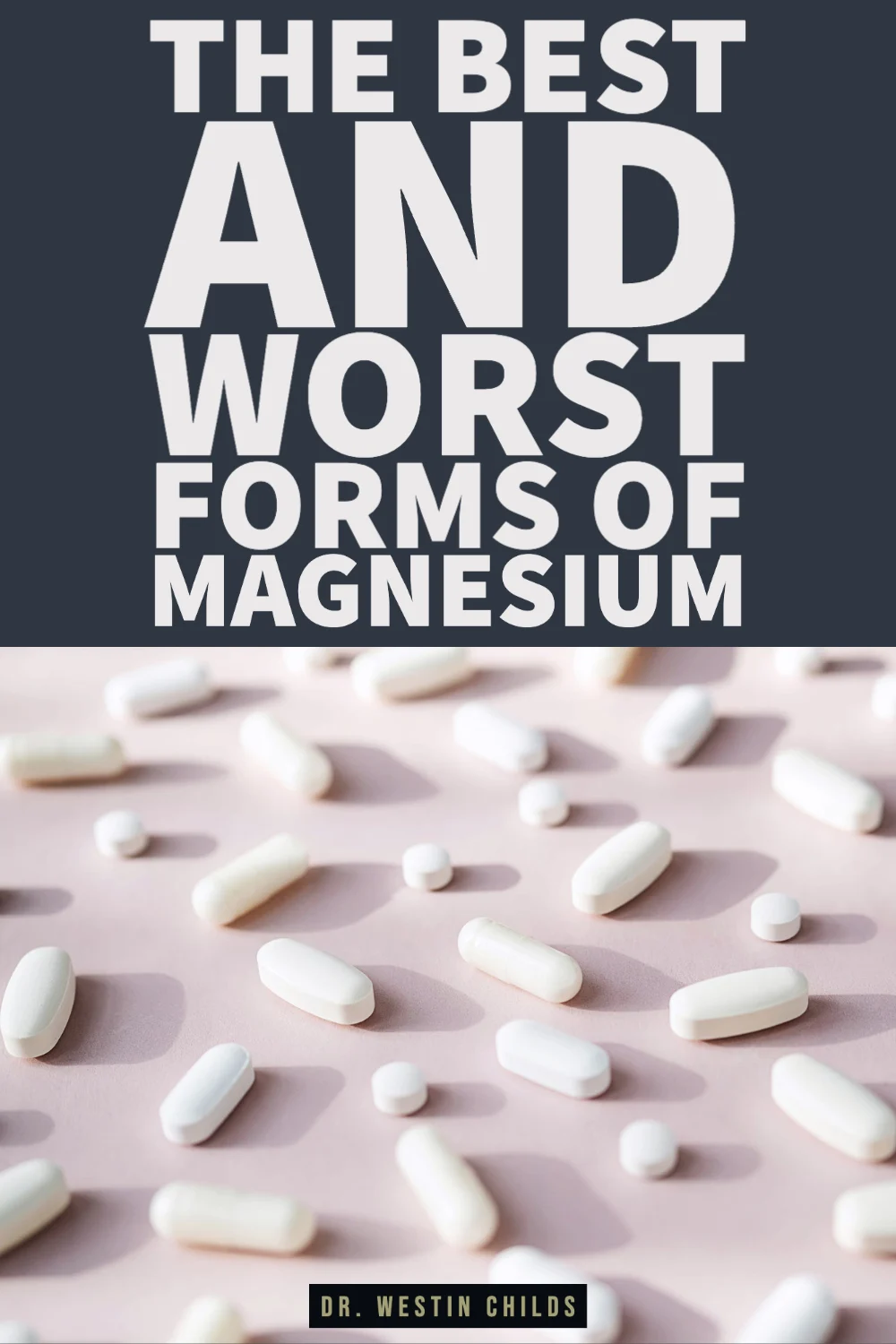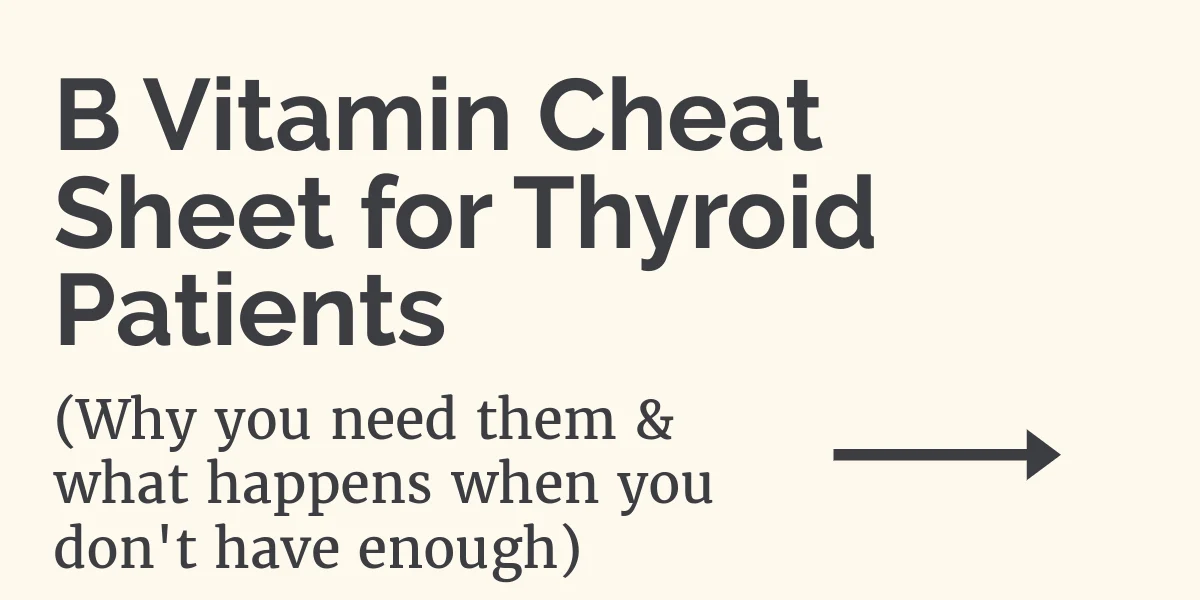Tons of people, probably including you listening to this right now, are not getting enough magnesium.
And this is a big deal because magnesium is used by the body for over 300 different enzymatic reactions (1).
Not having enough magnesium leads to symptoms like fatigue, nausea, stress and anxiety, insomnia, muscle spasms, thyroid problems, headaches, and many more.
But you probably already know that.
So today, instead of focusing on the symptoms, let’s talk about how to fix the problem of low magnesium with the use of supplements.
And when it comes to supplements, you have a ton of different options.
But not all of these options are created equal and not all options work for the same conditions.
For instance, if you want to replace low magnesium AND simultaneously improve brain health, well, there’s a specific form of magnesium for that.
If on the other hand, you want to replace low magnesium AND simultaneously treat constipation, well, there’s a specific form for that as well.
Let’s talk about the BEST and worst forms of magnesium, and which one(s) you should be using depending on your symptoms.
I’ll also share my personal favorite and the ones that I use the most often.
Why Different Magnesium Formulations Exist
Before we talk about that, though, you need to know one thing:
And that is that magnesium is always bound to some other compound. This is because magnesium is very poorly absorbed by itself (2).
And the compound that it is bound to, improves its absorption (or not, as you will soon find out) and sometimes provide additional benefits on its own.
Whenever I refer to a type or form of magnesium, what I’m talking about is the compound that it is bound to and the impact that this compound has on the function of magnesium when it is absorbed.
Make sense? Great, let’s jump in:
#1. Magnesium Oxide.
Magnesium oxide is a non-chelated form of magnesium bound to an organic acid or a fatty acid.
This is the cheapest formulation of magnesium and should be avoided by most people!
Based on available research, it has an absorption rate of less than 5% (3)!
It’s also the form that is most commonly found in supplements because of its cost.
Low-quality supplements often use this form because the other better forms are more expensive.
So you think you’re getting a good deal when in reality, you’re using the cheapest and least bioavailable form of magnesium out there.
Magnesium oxide isn’t completely worthless, but it’s not a great form for increasing total magnesium levels in the body.
If you want to use it, for whatever reason, its best use case is for constipation (4).
But don’t expect any significant amount to make it into your body to provide relief from the symptoms I mentioned earlier.
My final verdict: don’t use this form of magnesium! There are way better options out there.
You can check to see if your supplement uses this form of magnesium by looking at the supplement fact panel on the back of the bottle.
It should say something like magnesium as “blank”, if it says magnesium as “magnesium oxide” then that’s a pretty good sign that the overall quality of that supplement is very low and should be discarded in favor of one that is better.
#2. Magnesium Citrate.
Magnesium citrate is magnesium bound to citric acid.
This form of magnesium has laxative properties and is probably the best option to use for those suffering from constipation.
Most of the magnesium in this formulation will stay in your gut and pull water into your intestines, which is why it’s effective for constipation.
Magnesium citrate will give you a solid combination of total body magnesium and better stool support, but do realize that a lot of the magnesium here will be excreted and may not make it into your body.
The dose of magnesium citrate can range from 200 mg all the way up to 1,000 mg or higher.
The best way to use it is to titrate, which means slowly increasing your dose by 100 to 150 mg increments until you feel your stool soften.
If you develop diarrhea, then simply back down on your dose, and the problem will be solved.
#3. Magnesium Malate.
This form of magnesium is bound to a compound called malic acid.
Magnesium malate tries to take advantage of binding magnesium to a substance that the body could theoretically benefit from.
You can imagine that after it gets absorbed and split apart, the body would utilize magnesium for cellular functions and the malic acid component for other functions.
Malic acid is an alpha-hydroxy acid (5) found naturally in fruits and wines and is commonly used to treat dry mouth and fatigue.
Binding magnesium to malic acid improves the absorption of magnesium in the body and provides you with an additional helpful ingredient.
This form is ideal for increasing whole-body magnesium, increasing energy levels, and treating pain syndromes.
So if you have something like fibromyalgia along with fatigue, this would be the best form for you.
Just be aware that this form of magnesium can be stimulating, though, so you wouldn’t want to take it in the evening.
If you are looking to use magnesium for its calming benefits, this is not the best form!
Dosing for magnesium malate is around 300 to 400 mg per day. Make sure to take it in the morning or at lunchtime, but definitely not in the evening.
#4. Magnesium l-Threonate.
This form of magnesium is bound to a compound that helps magnesium cross the blood-brain barrier and has been shown to increase magnesium concentrations in the brain (6), making it the best form of magnesium for conditions like headaches, migraines, depression, and anxiety.
The only problem is that it doesn’t look like it’s a great form for increasing total body magnesium, even though it is well absorbed.
Some studies have shown that this form of magnesium gets excreted out of the urine in high amounts making it a less than ideal form for increasing total body magnesium.

But if you have neurological conditions like depression, anxiety, and so on, then this is still probably the best form to use.
Dosing for magnesium threonate is much higher than other forms at around 1,500 mg to 2,000 mg per day.
It’s not recommended to exceed 2,000 mg per day (because that’s the dosing used in various studies), but there’s probably no harm in exceeding it.
This higher dose is probably also required due to the higher excretion rate, which is why I don’t recommend it for improving magnesium in the entire body.
#5 Magnesium Glycinate (My Personal Favorite).
Magnesium glycinate is a chelated version of magnesium that is bound to an amino acid (glycine, in this case) to improve its absorption.
Magnesium glycinate contains the perfect combination of cost and effectiveness.
You get the biggest bang for your buck, and you get a well-rounded form of magnesium that improves total body magnesium, still helps slightly with brain-related conditions, and will still have some impact on constipation.
If you don’t need any additional fancy benefits and you are just looking for an overall high-quality form of magnesium, then magnesium glycinate is the best choice.
This is the form that I use the most frequently in my own supplements that I formulate.
Dosing for magnesium glycinate is around 300 to 400 mg per day but you can also go much higher than that.
The extra glycine you get from higher magnesium doses isn’t harmful and even has anti-inflammatory and antioxidant properties.
Use magnesium glycinate for sleep, depression, anxiety (7), muscle spasms, stress, and thyroid problems.
#6. Magnesium Orotate.
This form of magnesium is bound to a compound called orotic acid. It is not water-soluble, which means it won’t help much with magnesium, but it may help improve energy production in cells.
It’s not the most ideal form of magnesium, though, because it’s generally quite expensive. So even though it has high bioavailability, I generally don’t recommend its use.
It’s probably best used to support high-energy tissues and for improving athletic performances and heart health (8).
The dose would be around 300 to 400 mg taken each day.
#7. Sucrosomial Magnesium.
Sucrosomial magnesium is magnesium oxide covered by phospholipids in a sucrester matrix.
The encapsulation of magnesium ions increases movement across the gastric and intestinal tracts without the need for interaction with the intestinal mucosa.
In other words, it’s highly absorbed (9) compared to other forms of magnesium.
It also happens to be expensive.
I haven’t tested sucrosomial magnesium much at this point but when I do, I’ll come back and provide more information.
For now, it looks like this form of magnesium is best used for athletic performance, regulating blood pressure, managing mood, improving sleep, improving bone health, balancing blood sugar, supporting cardiovascular health, and treating migraines.
Theoretically, you would need less sucrosomial magnesium given its high absorption rate, but doses still around 200 to 300 mg per day would be ideal.
Final Thoughts
If I could condense all of this information down to just two forms, I would say stick to magnesium glycinate and magnesium citrate.
These two forms are well-absorbed, have a strong safety profile, and are relatively cheap.
We just spent a lot of time talking about how to get more magnesium from supplements, but you also shouldn’t neglect your diet as a source of magnesium!
My recommendation is to focus on eating as many magnesium-rich foods as possibl,e and in order to do that, you’ll want to check out this article.
Now I want to hear from you:
Were you aware of the importance of magnesium?
Did you know that there were so many different types of magnesium out there? Or that some forms are better than others?
What type of magnesium are you taking right now? Is it working for you?
Leave your questions or comments below!
Scientific References
#1. ncbi.nlm.nih.gov/pmc/articles/PMC4379450/
#2. ncbi.nlm.nih.gov/pmc/articles/PMC6683096/
#3. pubmed.ncbi.nlm.nih.gov/11794633/
#4. ncbi.nlm.nih.gov/pmc/articles/PMC7911806/
#5. ncbi.nlm.nih.gov/pmc/articles/PMC7009688/
#6. ncbi.nlm.nih.gov/pmc/articles/PMC9786204/
#7. ncbi.nlm.nih.gov/pmc/articles/PMC5452159/
#8. pubmed.ncbi.nlm.nih.gov/16366126/
#9. pubmed.ncbi.nlm.nih.gov/29630135/










I’m on Armour and was taking 60 mg. but had low energy.My tsh always is too low. I talked my Dr. into letting me have 75 MG. and my energy level is better but, of course, my tsh is lower. Is there anything else that would help me with energy? I’m 83 but still ride my bike to the gym and work out 3 x a week. I don’t want to lose my fitness because of low energy.
.
Hi Nancy,
Yes! Lots of things. My personal favorite would be the use of adaptogens such as those that are found in this supplement: https://www.restartmed.com/product/thyroid-adrenal-reset-complex/
You can also find additional information on how to increase energy here: https://www.restartmed.com/thyroid-fatigue/
What are your thoughts in the magnesium in Epsom salts? Are there risks if used too often?
Hi Jan,
Epsom salt is fine but I think oral magnesium is better if you are trying to increase systemic magnesium levels. Epsom salt is great for aches and pains, though.
I was prescribed Magnesium by my cardiologist to help control AFib episodes. Interestingly enough, the form that I am on is Magnesium Oxide! The one you say is the worst choice! I am prompted by your article to seek the guidance of my current cardiologist to see if they will switch me to another type of Magnesium that is better. What are your thoughts on magnesium for heart rhythm/rate issues?
Hi Susanne,
Magnesium is great for cardiac and heart health but I wouldn’t count on your cardiologist to know much about magnesium supplements. In general, cardiologists and conventional doctors know a lot about medications, but not so much about natural treatments or supplements. You may get lucky, but make sure to do your own research just to be on the safe side.
Ha, I am taking Magnesium Aspartate Dihydrate, which you have not mentioned. It was given to my wife (who passed away) in hosp. She had low mag levels – I know – very vague, but I have high blood pressure and Aorta dissections Type A and Type B. The operation is too high risk at the moment. Aorta Type A dissection measures 45mm and Type B 52mm, and they want to wait till 60-65mm. In the meantime, I want to use Magnesium to support the Aorta however possible, perhaps to improve elasticity and the possibility of further cracking. As it is, the crack runs the length of the Aorta, and the blood flow is partially through the layers, and the risk of very long stenting after repositioning the carotids is paraplegia. Am I taking the best form of Mag for my needs?
What are your thoughts on Magnesium Taurate? It isn’t on your list, but it’s been the only kind of magnesium that helps me with my night time leg cramps. I take the KAL brand, which has 400mg per serving, plus 25mg B-6 in an ActiSorb base with Bioperene and other extracts.
Hi Doctor Childs,
You don’t mention Magnesium Sulphate. Would you mind giving me your opinion on supplementing with Epsom Salts. Many thanks for your helpful information.
Regards, Lesley
Would you comment on magnesium and calcium balance. I had half my thyroid and 2 parathyroid glands removed. Endocrinologist recommended vitamin D and high dose calcium for osteoporosis but didn’t say anything about magnesium. (I refused bisphosphonates)
Hi Carol,
I already have that topic on my list of future blog posts so, hopefully, I will be able to get to it soon. In the meantime, I think you will find the information in this article helpful as it explains the benefits of using vitamin K2 and its impact on calcium regulation, bone health, and cardiovascular health in the setting of thyroid dysfunction: https://www.restartmed.com/thyroid-patients-need-vitamin-k2/
Are there any products that include more than one form of magnesium, or should they be taken in separate products?
Penny,
We’ve been getting this one – threonate, glycinate, and malate. I keep Citrate on hand as well in case someone needs to poop.
https://www.amazon.com/gp/product/B08MTNZH1L/
Hey there!
What are your thoughts on a topical magnesium lotion? In particular the ingredient, Magnesium Chloride Brine? Thank you for all that you do!
I alternate between magnesium glycinate and citrate 250 mg. I suffer with constipattion and trouble sleeping more than 6 hours a night. Not sure if it’s helping with either!
Why do doctors who specialize in migraine recommend magnesium oxide? I keep reading that it’s not highly absorbable but they seem to prefer that type of magnesium. Wondering if it’s because that’s what the studies used or if there is a specific reason it might be considered more effective in the case of migraine.
Hi,
I would like to say that magnesium citrate is not a good choice for anyone with allergies to mold. Magnesium citrate comes from citric acid. Citric acid is made from mold on corn and is an industrial chemical.
It’s a fungus called aspergillus Nigel. I personally don’t like the idea of putting mold,fungus and industrial chemicals in my body. It’s an easy search to see what I posted is accurate. I do agree with taking magnesium ( not oxide either, as anything oxidized loses it’s potential benefits). As with anything ( especially anything that goes in your body) research like crazy.
You may want to read up on the other popular form of magnesium and update this article, and possibly start selling your own brand of it. This article doesn’t address one of the most popular and most effective forms of magnesium, which is elemental magnesium in nano and even smaller pico size, always in a liquid form. Pico is claimed to be the best out there, although I’ve had similar results from larger nano magnesium, which is taken by ingestion or by absorption through skin. Research shows that magnesium for skin absorption must be pure and liquid only, never in a lotion, because the lipophilic barrier would prevent absorption. And so it must be always sprayed as a pure liquid and then, due to dead skin-cells and other inhibitory actions of the skin-barrier, it must be sprayed onto sweat glands or densely populated hair-follicle locations, always after cleaning and drying to remove dead skin-cells, so that it will absorb properly. The ideal location seems to be sweat glands, because not everyone washes their hair each and every day. But, anyone can apply this on their scalp or under their arms, first thing after bathing and drying quickly, to see a dramatic increase in magnesium levels. As a note of caution, given how many physicians currently recommend that pregnant women rub magnesium on their bellies, to increase levels, while there is a benefit to skin from this and a benefit to blood-flow from massage, the reality stands that dead skin-cells prevent absorption, as they have no transport-mechanism to move the magnesium into the body, and so magnesium levels do not dramatically increase by this method. What we see in research is that, on clean dry skin, where there are many hair follicles or dense sweat glands and where the patient has just bathed and has not applied any lipid barrier such as is seen in many hair-conditioners and body-lotions, magnesium is shown to absorb well through the active-transport pores in the skin. This is why we absorb so very readily through the soles of our feet. I hope you’ll look into it. Not enough doctors out there are honest about the limitations of skin application nor the benefits of nano and pico magnesium, as compared to capsule and tablet forms.
Where can I find this type of magnesium? What brand do you use? Thanks!
Thank you, Dr. Child’s, for this info regarding best forms of magnesium for hypothyroid! I have been taking the two forms you mentioned, L-Threonate (2000 mg) and Magnesium Bisglycinate (400 mg)…some at lunch and the rest at bedtime. The magnesium bisglycinate on the label seems to also include some “oxide” as a secondary ingredient (?), totaling 200 mg for each capsule. Maybe I should look for a better product without any oxide because it does not indicate on the label what the ratio is; how much bisglycinate and how much oxide!
Thank you!
My Mg seems to be a combination an oxide, gluconate and lactate. So, are gluconic and lactic acid salts any better at absorption than some others you mentioned, or should I just discard this lot? Thanks. Elizabeth
I have the same question. I’m dealing with gastritis, constipation, AND restless legs… and bisglycinate makes the restless legs far worse for me… so finding the right amount of each type is hard! Mag citrate has to be taken in careful measure as too much is too acidic & hard on the gastritis, oxide is good for that as it’s bland and decent for constipation but doesn’t help legs…
Dr. Childs, I am on synthroid 137 mcg since RI in the 90’s. I have mag Bisglycinate. Is that the same is glycinate and what other vit/min do I need to take with it to help it work? I also live with chronic pain.
Thanks
I was taking magnesium citrate, but did not see any improvement for energy or sleep. I just became aware of magnesium glycinate being a better choice so I am switching. The one I purchased, however, says magnesium (as magnesium glycinate)60 mg and magnesium Glycinate 400 mg. Why would it be worded that way? Is there a particular form that is best? This is a capsule. When is it best taken?
I read your magnesium article with much interest. For several years now I have been taking a supplement that has 3 different kinds of magnesium: L-Threonate 1000mg, glycinate 690mg and Taurate 630 mg. I take it at night and it helps me sleep. It’s supposed to help cognitive, muscle and nervous system function. I’d love to know your thoughts on this product.
Toni
What about Ionic Mgcl? This was recommended by another holistic doctor.
I take 250 mg of glycinate at night to treat the achy heavy feeling in my lower legs. This symptom seems to appear in the evening and disturbs my sleep. I cannot take the citrate form due to its laxative affect. I’ve had the best luck with the Purology brand.
I have hashimotos and take NPthyroid. I have been reducing my dosage from a high of 90mg to 30mg/4 days/wk and 60mg the other 3.
I am on Magnesium Lactate. I take one tab of 84 mg per capsule. I get more magnesium through other vitamin sources,too. Is magnesium lactate OK? Also what is the best kind of Iron and Calcium to take and how much? I have hypothyroidism/Hashimoto’s and osteoporosis and osteopenia. Thank you
I recently began taking magnesium, as I am preparing to begin fasting #2 with your suggested 4 meals. I also suffer from hypothyroidism, struggle to sleep, and chronic pain due to osteoarthritis.
The brand I have states: magnesium biglycinate, chelate buffered and magnesium oxide.
Is biglycinate different than glycinate?
Should I look for another brand that doesn’t refer to oxide at all?
Thanks!
At last, somebody finally gets down to the facts and breaks down the uses for each type of magnesium supplement. I did not know there were so many different types of magnesium until recently reading about them. I am 67 years old and still like to do keep fit exercises. I also suffer from bloatedness caused by IBS. The brand I usually take is Vitabiotics, but on their carton, it just names it as ultra, premium quality. It states in the directions for use: two tablets per day. I have found this to be over the top as I have quite a good diet and indeed experienced the effects of diarrhea when taking two tablets. I feel much better taking just one tablet. I think it is down to the individual to experiment as each person’s diet and lifestyle vary. Thank you very much Dr. Childs for your time. I notice a lot of the magnesium supplements are very expensive and wonder if they need to be, particularly when the latest craze kicks in. Could you please advise if the Glycinate is preferable for my needs given my age and exercise routine or would the Citrate be a better option ? Also, the Vitabiotics ultra magnesium premium quality brand does not state what type of magnesium it is. I am not sure whether to carry on with it. I appreciate that you should not be biased against any particular brand but would appreciate any advice given.
Hi John,
I generally think that glycinate is best to start with unless you are specifically trying to treat constipation or struggle with that particular issue.
Magnesium glycinate makes me VERY sad.. depression .. which I don’t usually have. I mean it was scary .. taking it for my muscles. Tried the Tylenol Arthritis which has magnesium sterate in it . Though the label doesn’t say how much .. but it had a similar affect , but not near quite as BAD . Is there an ingestable form I can take for muscles , that doesn’t have this sadness effect? Thank you
Hi Colleen,
In general, magnesium should have no impact on your mood, but if you find it does, for whatever reason, you can try taking sucrosomial magnesium or, really, any other type.
Magnesium stearate is a flow agent, though, and is never really used in any meaningful amount, so it’s highly unlikely to cause symptoms at all.
What magnesium do you recommend for leg cramps? Should you take vit. B with it & take am or pm ?
Hi Paula,
Magnesium glycinate is generally best to get it to all of your tissues. B vitamins can be taken with magnesium if needed.
You can see that form of magnesium here: https://www.restartmed.com/product/thyroid-daily-essentials-thyroid-multivitamin/
Hi Dr Childs,
I’m currently taking Magnesium Glycinate, and B 12. I was diagnosed with Hashimoto’s disease If I decide on the Berberine when should I take it and can it be taken with the Glycinate and B 12. Together or separate? I currently take the Glycine and B12 in the morning.
Thank you!
Hi Toni,
You can take magnesium at any time of the day, just experiment to see what works best for your body.
Hi Dr. Child’s!
I am so glad yo have found your information!!
I have been taking Magnesium Malate for about a month because of fibromyalgia and other pain challenges (I need a hip replacement. ) I have hypothyroidism, headaches and depression, so I am wondering if I should add Magnesium Glycinate. Would taking both be too much? I look forward to your response!
Hi Lori,
Doubling up on magnesium is usually not an issue.
I’ve had my thyroid removed 23 years ago I’m 54 years old now on Levothyroxine 100 micogram for 24 years but all of the sudden my T4 is always even slightly high I can feel the symtoms of hyperthyroidism.
The wooshing sound inside my head and I can hear my heartbeat inside my head I get the internal tremors I keep telling doctor something isn’t right my hear rates are high over 100 per minute. I keep telling the doctor something isn’t right because I know the symptoms are of elevated T4 and I keep telling them there is some medicine interfering with my Levothyroxine or I have defiency of something but they just say you need to pycatist I tell them that I’m already on antidepressants they asked if I took diazepam 5 mg helps I said no so now I’ve got heart arthrmia they put me on beta block which made me worse. I have chronic muscle, and nerve pain, neck, shoulders, lower, middle, upper back pain. I feel numb in legs and out of balance. My head feels really hot inside as if I have heated inside my head. I know the symptoms of over medicating because I was once severely over medicated they did every test they can to find nothin and I told them this is throxine poisoning they decided to check after 9 month of being bid ridden only to find out I was right this was almost 2 years ago.
I’m getting those Symtoms now but my T4 is consisted normal range for me if my t4 is slightly elevated I get the symtoms of being over medicated. I’ve done my test early morning without taking my Levothyroxine.
I’m so confused and tired of being tired.
What are you thoughts ?
Hi Heidi,
Years ago we switched our mother from the synthetic Levothyrox to thyreoïdum, the natural thyroid hormone obtained from the thyroid glands of pigs. It changed her life for the better in every possible way.
Please do your research which natural replacements for Levothyroxine are available where you are and get the dose right with the help of your GP. You will notice the enormous difference as well.
Good luck and even better health to you!
Dr. child I take magnesium citrate 100mg but for some reason about 6 hours after I take it I regurgitate it. I was taking it to help my headach. It’s in a capsule form can I break it apart and put it in water. Or do you think I should try it in a soft gel.
Hi Velda,
It’s probably best to just try a different form of magnesium if you don’t tolerate mag citrate.